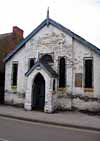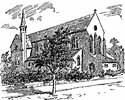For this church:    |
Retford (Ordsall) St AlbanHistory
The district of South Retford covered the northern part of the parish of Ordsall and had grown rapidly since the arrival of the railways in the second half of the 19th century and by 1899 had a population of around 5,000. Ordsall parish church was a mile away, could only accommodate 250 people and muddy fields and railway tracks made it difficult to access from this part of the parish so since 1893 the parishioners of South Retford had been worshipping at the mission room on Albert Road, known as the Albert Hall. It was, however, a rented building and only a temporary solution. In May 1898 a syndicate consisting of Thomas Bescoby, the Rev. Thomas Gough, J.H. Hewitt, J.W. Holmes, S. Jones and the Rev. Dr S. W. Stott (rector of Ordsall) had been formed to purchase the Holly Mount Estate on London Road which was considered a good location for a new church. Once the land had been bought an area 71ft wide by 240ft long was marked off for the church and the remainder was subsequently sold off enabling the syndicate to convey the site to the church building committee free of charge. On 20 June 1899 the Bishop of Derby presided over a public meeting at Retford Town Hall ‘for the purpose of furthering a scheme of church extension for South Retford.’ The Rev. S. W. Scott stressed the urgent need for a new church to serve the district and outlined three suggestions before the meeting: 'one for an iron church, a second for a nave only to form a portion of a building to be subsequently completed, and a third for a complete permanent structure.' He announced that a site had been secured free of cost, and that funds had been given or promised. The proposal that 'this meeting approves the movement of church extension in the parish of Ordsall, and will use its best endeavours to meet the same' was carried. The meeting raised the profile of the proposed new church and by July 1899 £1,516 had been raised or promised.
The Durham architect, Charles Hodgson Fowler, was engaged to prepare plans for the new church which could be built at an estimated cost of £6,800. Subscriptions and promises of subscriptions only amounted to £2,524 so a tender from Messrs Bowman & Sons of Stamford to only build the eastern section of the church at a maximum cost of £3,126 12s 8d was accepted in February 1902. Further costs were £130 for the turret, £65 for the heating equipment, about £180 for furnishings and fittings and £200 for the organ which included its removal from a premises in London and delivery to Retford. With other various sundry costs the account found itself in deficit to the amount of £1,200. When fully completed the church would seat 500 but the first phase of the building project it would only provide accommodation for 200. In addition £400 was spent erecting a temporary parish room in 1902. The parish room was built of corrugated iron and used from the outset as a place of worship and for the Sunday School.
On 23 July 1902 the foundation stone of the new church was laid by the Rt. Hon. F.J.S. Foljambe, Lord High Steward of East Retford. A sealed bottle was placed in a cavity prepared for it under the stone. It contained a copy of the Order of Service printed on vellum, a copy of the Subscription List, a copy of the current issue of the Retford Times, one of the Coronation Medals presented by the Mayoress to the children of the Borough, and a few coins of the new issue of King Edward VII. On 22 June 1903 the Bishop of Derby conducted the service at the opening and dedication of St Alban’s church which was licensed as a Chapel of Ease for the Parish of Ordsall. The church at this point only consisted of chancel, choir and side aisles. A temporary west front was constructed of galvanised iron.
Stott died in December 1907 and fundraising for the completion of the church lost some of its momentum. It took another five years for sufficient funds to be raised to resume building and on 18 September 1912 the foundation stone for three bays of the nave was laid by W.H. Mason of Morton Hall. Hodgson Fowler died in 1911 and the architect of this stage of work was W. H. Wood of Newcastle. The church was consecrated on 11 May 1913 by the Bishop of Southwell. By this point the cost of building had risen to £7,500. The west end was blocked up with corrugated iron sheets which were held in position by huge wooden beams set in concrete. It became known as ‘the tin end’. The Bishop of Southwell's parochial visitation of 1912 reported that St Alban's could accomodate 250 worshippers. During the First World War members of the St Alban's choir volunteered for action. Sergeant Leslie Green of the Sherwood Foresters was awarded the Distinguished Conduct Medal in 1917 and a Military Medal for courage the following year and promoted to Lieutenant. Frank Stockdale died when the troopship ‘Royal Edward’ was sunk in the Aegean Sea in 1915 and William Gleaden, a sergeant in the Leicestershire Regiment and a bass in the choir for 14 years, was killed in action in France in October 1918.
Progress on completing the church stalled, in part due to the First World War, but in 1925 the energetic and capable Reginald Wilkinson was appointed rector of Ordsall parish. A series of bazaars were organised in the late 1920s and in May 1930 work started on building the last two bays of the nave and the west wall. W. H. Wood was again employed as architect and he used the same builders as in 1912-13. On 22 April 1931 the Bishop of Southwell dedicated the new part of the church. Baptisms and funerals had been held in the church since its opening but St Albans was not licensed for weddings until 1936. The first wedding, on October 21 1936, was that of Keith Erskine and Kathleen Keyser of Eaton Hall, near Retford. The bride had for many years been an active member of the church. There was a lively social life at the church in the 1930s and 1950s. The St Albans Players produced a number of plays, the Tennis Club had grass courts on Richard Street and had 52 members in 1930, and the St Albans branch of the Church of England Men’s Society was formed in 1955 and for 20 years had a programme of outings and varied activities, including visits to Longbridge car plant, Rampton Secure Hospital and RAF Scampton in Lincolnshire. The choir also had an active social life: Christmas parties, bonfire nights, annual trips to Skegness and a weekly Boys’ Club that included badminton, billiards and tennis. By 1996 the congregation had dwindled in numbers and the decision was made to develop the church as a local arts centre. The intention was that the arts centre activities would be run by a separate organisation that would take responsibility for the nave (which would be deconsecrated) while the chancel would be used for worship. A wide range of events took place over the coming years: exhibitions, plays, craft workshops, concerts and poetry cafes. Although well attended the arts centre failed to make enough money to support the church so the arts centre was wound up. This decision ultimately led to the closure of the church in the autumn of 2003. The church and hall were put up for sale and although there were several expressions of interest the buildings suffered vandalism and theft. On 7 August 2008 there was an arson attack and the roof and the remaining internal fittings were destroyed. The walls were supported by scaffolding but the site became an derelict eyesore for several years. In 2019 Bassetlaw District Council gave planning permission for the conversion of the church into 10 duplex apartments. |










